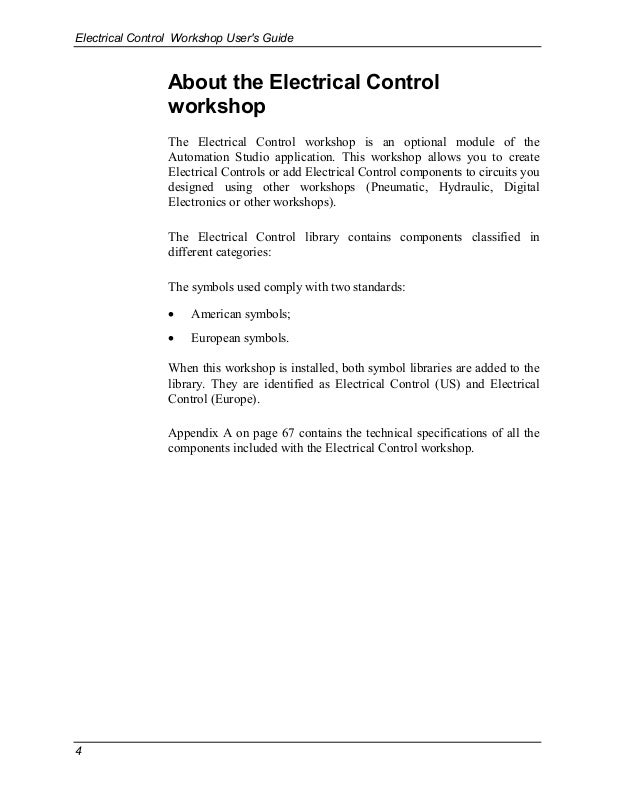Automation Studio 6 Library
Hydraulic and Pneumatic Simulation Software. Automation Studio™ is an innovative system design, simulation and project documentation sofware solution for the design and support of automation and fluid power systems. May 27, 2016 I am trying to use SCCM 2012 to install Automation Studio 6.2 silently, in SCCM I simply navigate to the folder we have the files in on our UNC path and invoke 'setup.exe -s'. The setup is able to start on the PC (I actually see the setup in the task manager) but it does not finish. I can make it fully install when doing it manually.
P6.2/E6.2 and later,, Website Automation Studio is a circuit design, simulation and project documentation software for systems and electrical projects conceived by Famic Technologies Inc. It is used for,, and training purposes.
Mainly used by, trainers, and service and maintenance personnel. Automation Studio can be applied in the design, training and troubleshooting of,,, and electrical control systems. Two versions of the software exist: • Automation Studio Professional • Automation Studio Educational The educational version of Automation Studio is a lighter version used by engineering and technical schools to train future engineers and technicians. The software is designed for schools that teach technical subjects such as industrial technologies, mechatronics, electromechanical technologies, electrical & electronics, automation, and maintenance. Modeling and simulation are used to illustrate theoretical aspects.
Automation Studio 6 Library Hours
Contents • • • • • • • • • • Libraries [ ] Automation Studio has various symbol libraries. All libraries follow standards such as ISO, IEC, JIC and NEMA. • Hydraulics • Pneumatics • Electrical (IEC & NEMA standards) • Fluid Power & Electrical Component Sizing • Valve Spool Designer • OPC communications server • Bill of Materials & Report • PLC Ladder Logic • HMI & Control Panel • Digital Electronics • Sequential Function Chart (GRAFCET) • Electrical Controls • Multi-Fluid Simulation • Teachware • Manufacturer's Catalogue • Workflow Manager Libraries features [ ] Automation Studio is used as a design and simulation tool in the fields of hydraulics, pneumatics, electrical and automation. Automation Studio Hydraulics [ ] Automation Studio Hydraulics’ functions are used for hydraulic system engineering purposes. Automation Studio Hydraulics includes a specific symbol library and uses modeling techniques such the Bernoulli’s law and the gradient method. Automation Studio Hydraulics is the main aspect of Automation Studio: it is used to conceive and to test hydraulic systems while taking into account thermal parameters.
It displays inside views of the elements in the schematics. The Automation Studio library includes additional elements such as commands and control devices (PID controller,, and servo-direction). Fluid power is one of the central elements in such simulation. Automation Studio Pneumatics [ ] Automation Studio Pneumatics is similar to Automation Studio Hydraulics, but the simulation is done for air rather than fluids.

This library, like Automation Studio Hydraulics, is used to design and test models. Thus, the simulation elements that are used are not the same as those in the hydraulics library. Automation Studio Electrotechnical [ ] The electrotechnical module in Automation Studio is used for design, simulation, validation, documentation and troubleshooting of electrical diagrams. It includes multi-line and one-line representation according to the users' choice. The different aspects of the IEC and NEMA international standards are respected: components’ identification, symbols, ratings, ports names, etc. The electrotechnical module works simultaneously with the fluid power technologies which allows the users to design and simulate complete systems. Versions [ ] Automation Studio Professional [ ] • 1996-2000: 1.0 to 3.0.5.1 (Windows 98, 2000, Me, XP, NT 4.0); • 2003-2004: 4.0, 4.1, 5.0, 5.1, 5.2 (Windows 2000, XP, NT 4.0); • 2005-2006: 5.3, 5.4 (Windows 2000, 2003, XP); • 2007: 5.5 (Windows XP, Vista); • 2008: 5.6 (Windows XP, Vista); • 2009: 5.7 (Windows XP, Vista); • 2011: 6.0 (Windows XP, Windows 7, Windows 8); • 2014: 6.1 (Windows 7, Windows 8); • 2016: 6.2 (Windows 7, Windows 8, Windows 10, Vista).